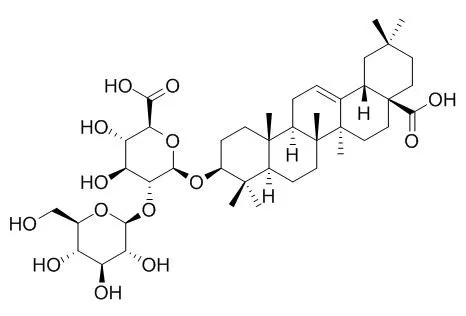| In vitro: |
| Planta Med. 1994 Jun;60(3):240-3. | | Inhibitory effect of some triterpenoid saponins on glucose transport in tumor cells and its application to in vitro cytotoxic and antiviral activities.[Pubmed: 8073091] |
METHODS AND RESULTS:
The effects of some triterpenoid saponins on glucose transport in Ehrlich ascites tumor (EAT) cells were examined by measuring 2-deoxy-D-glucose (2-DG) uptake. The correlation of the effects with those on the growth of a human T-cell line (MT-4) and the replication of human immunodeficiency virus in MT-4 cells was also studied.
CONCLUSIONS:
Chikusetsusaponin Ia isolated from rhizomes of Panax japonicus C. A. Meyer (Araliaceae) inhibited the 2-DG uptake (IC50 = 76.3 microM) in a competitive fashion with respect to 2-DG (Ki = 0.32 mM) and the growth of MT-4 cells with CC50 of 84.4 microM, whereas it did not show any significant anti-HIV-1 activity.
In contrast, Zingibroside R1 isolated from rhizomes of Panax zingiberensis Wu et Feng (Araliaceae) showed some anti-HIV-1 activity, which was found to be superior to that of glycyrrhizin, as well as the inhibitory effects on the 2-DG uptake by EAT cells (IC50 = 91.3 microM) and the growth of MT-4 cells (CC50 = 46.2 microM). | | Chem Pharm Bull (Tokyo) . 2013;61(3):344-50. | | Saponins composition of rhizomes, taproots, and lateral roots of Satsuma-ninjin (Panax japonicus)[Pubmed: 23291557] | | Abstract
A new dammarane-type triterpenoid saponin, chikusetsusaponin VII (1), and nineteen known triterpenoid saponins, ginsenoside Rb1 (2), ginsenoside Rb3 (3), ginsenoside Rc (4), ginsenoside Rd (5), ginsenoside Re (6), ginsenoside Rg1 (7), ginsenoside Rg2 (8), ginsenoside Rh1 (9), notoginsenoside R1 (10), notoginsenoside R2 (11), notoginsenoside Fe (12), chikusetsusaponin IVa (13), chikusetsusaponin IV (14), chikusetsusaponin V (15), chikusetsusaponin VI (16), chikusetsusaponin FK6 (17), gypenoside XVII (18), 28-desglucosylchikusetsusaponin IV (19), and Zingibroside R1 (20), were isolated from rhizomes, taproots, and lateral roots of Panax japonicus C. A. Meyer, so-called "Satsuma-ninjin," grown in southern Miyazaki Prefecture, Japan. The structure of new chikusetsusaponin VII was elucidated on the basis of spectral and physicochemical evidence. Although the chemical composition of the rhizome was found to be similar to that of the "Chikusetsu-ninjin," the saponin composition of lateral root of "Satsuma-ninjin" was found to be close to that of lateral root of P. ginseng. The total yield of oleanolic acid saponins of the taproot was less than that of rhizome, but the total yield of dammarane-type saponins of the taproot was found to be similar to that of rhizome. |
|






 Cell. 2018 Jan 11;172(1-2):249-261.e12. doi: 10.1016/j.cell.2017.12.019.IF=36.216(2019)
Cell. 2018 Jan 11;172(1-2):249-261.e12. doi: 10.1016/j.cell.2017.12.019.IF=36.216(2019) Cell Metab. 2020 Mar 3;31(3):534-548.e5. doi: 10.1016/j.cmet.2020.01.002.IF=22.415(2019)
Cell Metab. 2020 Mar 3;31(3):534-548.e5. doi: 10.1016/j.cmet.2020.01.002.IF=22.415(2019) Mol Cell. 2017 Nov 16;68(4):673-685.e6. doi: 10.1016/j.molcel.2017.10.022.IF=14.548(2019)
Mol Cell. 2017 Nov 16;68(4):673-685.e6. doi: 10.1016/j.molcel.2017.10.022.IF=14.548(2019)